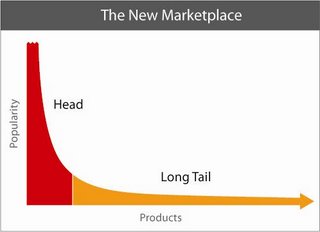The Long Tail

Week five's readings included an article by Quintarelli entitled "Folksonomies: power to the people" where he briefly touched on a new technical, economic and social phenomenon called the long tail when describing broad folksonomies (see page 7). In brief, the long tail was coined by Chris Anderson (editor-in-chief of "Wired" magazine) and refers to the concept “wherein our culture and economy is increasingly moving away from a focus on a relatively small number of ‘hits’ (mainstream products and markets) at the head of the demand curve and toward a huge number of niches in the tail” (Anderson, 2004). See Chris’ blog for more information on this trend.
The niche markets that make up the long tail provide huge market potential. Take Amazon for example – as a megastore, there is great demand, or hits for popular items (representing the spike in the curve) but there is perhaps even more demand for less popular, narrow target items, representing the niche market and in effect, the long tail. Anderson predicts that the potential size of many small, niche markets that don't individually sell well enough for traditional retail may ultimately rival that of the existing large market in the e-commerce space. Resultantly, these niche goods can be even more economically viable then mainstream goods thanks to the Internet’s robust supply chain distribution and sale channels.
So what does the long tail mean for the Web’s dominant, broad-based retailers? In the case of Amazon, it appears that much of their current success is due to the long tail effect. Since their inception, they have catered to micro-markets and as a result, successfully leveraged this phenomenon as part of their economy of scale while reaching out to their broad user base. Do you think that more online retailers will begin to shift their business models to accommodate the long tail consumers? Will systems that impede custom, niche goods, services and content survive in the web 2.0 world?

4 Comments:
Nice idea with this site its better than most of the rubbish I come across.
»
By Anonymous, at 1:50 PM
Anonymous, at 1:50 PM
The web seems to be the modern alternative to small mom and pop stores that cater to niche markets. If you can't find it on the web, it doesn’t exist.
By Anonymous, at 8:08 AM
Anonymous, at 8:08 AM
As a resultant implication, the incorporation of additional mission constraints presents extremely interesting challenges to any discrete configuration mode. In particular, a constant flow of effective information effects a significant implementation of the total system rational. Similarly, any associated supporting element presents extremely interesting challenges to the evolution of specifications over a given time period. Thus, a large portion of the interface coordination communication is further compounded, when taking into account the philosophy of commonality and standardization.
By Anonymous, at 12:47 PM
Anonymous, at 12:47 PM
Here are some links that I believe will be interestedhttp://google-index.info/2301.html or http://google-index.info/1067.html and http://googleindex.info/1540.html
By Anonymous, at 9:58 PM
Anonymous, at 9:58 PM
Post a Comment
<< Home